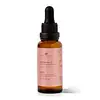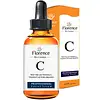What's inside
What's inside
 Key Ingredients
Key Ingredients

 Benefits
Benefits

 Concerns
Concerns

No concerns
 Ingredients Side-by-side
Ingredients Side-by-side

Water
Skin ConditioningGlycerin
Humectant3-Glyceryl Ascorbate
AntioxidantSodium Hyaluronate
HumectantFerulic Acid
AntimicrobialTocopheryl Acetate
AntioxidantSimmondsia Chinensis Seed Oil
EmollientCitrus Aurantium Dulcis Peel Oil
MaskingOlive Oil Glycereth-8 Esters
EmollientAloe Barbadensis Leaf Juice Powder
Skin ConditioningPhenoxyethanol
PreservativeXanthan Gum
EmulsifyingEthylhexylglycerin
Skin ConditioningSodium Citrate
BufferingCitric Acid
BufferingSodium Phytate
Water, Glycerin, 3-Glyceryl Ascorbate, Sodium Hyaluronate, Ferulic Acid, Tocopheryl Acetate, Simmondsia Chinensis Seed Oil, Citrus Aurantium Dulcis Peel Oil, Olive Oil Glycereth-8 Esters, Aloe Barbadensis Leaf Juice Powder, Phenoxyethanol, Xanthan Gum, Ethylhexylglycerin, Sodium Citrate, Citric Acid, Sodium Phytate
Water
Skin ConditioningSodium Ascorbyl Phosphate
AntioxidantAloe Barbadensis Leaf Juice
Skin ConditioningGlycerin
HumectantFerulic Acid
AntimicrobialHydrolyzed Hyaluronic Acid
HumectantSodium Hyaluronate
HumectantArginine
MaskingTaraxacum Officinale Extract
Skin ConditioningCentella Asiatica Extract
CleansingEquisetum Arvense Extract
AstringentCitrus Aurantium Amara Flower Water
MaskingHamamelis Virginiana Leaf Extract
Skin ConditioningSimmondsia Chinensis Seed Oil
EmollientCitrus Aurantium Dulcis Peel Oil
MaskingPhytic Acid
Benzyl Alcohol
PerfumingTocopheryl Acetate
AntioxidantPolyglyceryl-4 Caprate
EmulsifyingLimonene
PerfumingXanthan Gum
EmulsifyingEthylhexylglycerin
Skin ConditioningPotassium Sorbate
PreservativeSodium Benzoate
MaskingWater, Sodium Ascorbyl Phosphate, Aloe Barbadensis Leaf Juice, Glycerin, Ferulic Acid, Hydrolyzed Hyaluronic Acid, Sodium Hyaluronate, Arginine, Taraxacum Officinale Extract, Centella Asiatica Extract, Equisetum Arvense Extract, Citrus Aurantium Amara Flower Water, Hamamelis Virginiana Leaf Extract, Simmondsia Chinensis Seed Oil, Citrus Aurantium Dulcis Peel Oil, Phytic Acid, Benzyl Alcohol, Tocopheryl Acetate, Polyglyceryl-4 Caprate, Limonene, Xanthan Gum, Ethylhexylglycerin, Potassium Sorbate, Sodium Benzoate
Ingredients Explained
These ingredients are found in both products.
Ingredients higher up in an ingredient list are typically present in a larger amount.
Citrus Aurantium Dulcis Peel Oil is oil from the peel of an orange fruit.
Limonene and linalool make up the majority of oils from citrus peels. Limonene has a "citrus" fragrance. Citrus peels also contain flavonoids, which have anti-inflammatory properties.
Citrus peel is also a rich source of flavonoids. Flavonoids are natural antioxidants and help protect your skin against damage. Flavonoids are a group of compounds naturally found in vegetables and fruits.
The term 'fragrance' is not regulated in many countries. In many cases, it is up to the brand to define this term. For instance, many brands choose to label themselves as "fragrance-free" because they are not using synthetic fragrances. However, their products may still contain ingredients such as essential oils that are considered a fragrance.
Learn more about Citrus Aurantium Dulcis Peel OilEthylhexylglycerin (we can't pronounce this either) is commonly used as a preservative and skin softener. It is derived from glyceryl.
You might see Ethylhexylglycerin often paired with other preservatives such as phenoxyethanol. Ethylhexylglycerin has been found to increase the effectiveness of these other preservatives.
Ferulic Acid is a plant based antioxidant. By fighting free-radicals, ferulic acid can help reduce the formation of fine lines and hyperpigmentation.
When used with Vitamin C, Ferulic Acid has shown to prevent Vitamin C from breaking down. In other words, it acts as a stabilizer.
Ferulic Acid is sometimes used to preserve food. Foods containing Ferulic Acid include: oats, rice, eggplant, citrus.
In medicine, Ferulic Acid is being studied for helping with diabetes, Alzheimer's, and cardiovascular diseases.
Learn more about Ferulic AcidGlycerin is already naturally found in your skin. It helps moisturize and protect your skin.
A study from 2016 found glycerin to be more effective as a humectant than AHAs and hyaluronic acid.
As a humectant, it helps the skin stay hydrated by pulling moisture to your skin. The low molecular weight of glycerin allows it to pull moisture into the deeper layers of your skin.
Hydrated skin improves your skin barrier; Your skin barrier helps protect against irritants and bacteria.
Glycerin has also been found to have antimicrobial and antiviral properties. Due to these properties, glycerin is often used in wound and burn treatments.
In cosmetics, glycerin is usually derived from plants such as soybean or palm. However, it can also be sourced from animals, such as tallow or animal fat.
This ingredient is organic, colorless, odorless, and non-toxic.
Glycerin is the name for this ingredient in American English. British English uses Glycerol/Glycerine.
Learn more about GlycerinThis oil comes from the seeds of the desert shrub called Jojoba. It is more commonly known as jojoba oil, a non-comedogenic oil.
Jojoba oil does not contain fragrance and has many fatty-acids, making it a great soothing ingredient.
It also contains Vitamin E, a great moisturizing ingredient. Vitamin E is also an antioxidant and protects your skin against oxidative damage.
This ingredient humectant properties, meaning it helps draw moisture from the air. This helps keep your skin hydrated.
While jojoba has antibacterial properties, it is only able to kill some strains of bacteria.
Studies also show it helps in wound healing. In fact, Indigenous cultures have used jojoba as a moisturizer and to help treat burns for centuries.
Fun fact: Jojoba oil similar to natural human skin sebum, so it has a great effect on dry skin. It is also promising with helping to regulate sebum production.
Due to its fatty acid content, Jojoba oil may not be fungal acne safe. We recommend speaking with a professional if you have any concerns.
Learn more about Simmondsia Chinensis Seed OilSodium Hyaluronate is hyaluronic acid's salt form. It is commonly derived from the sodium salt of hyaluronic acid.
Like hyaluronic acid, it is great at holding water and acts as a humectant. This makes it a great skin hydrating ingredient.
Sodium Hyaluronate is naturally occurring in our bodies and is mostly found in eye fluid and joints.
These are some other common types of Hyaluronic Acid:
Learn more about Sodium HyaluronateTocopheryl Acetate is AKA Vitamin E. It is an antioxidant and protects your skin from free radicals. Free radicals damage the skin by breaking down collagen.
One study found using Tocopheryl Acetate with Vitamin C decreased the number of sunburned cells.
Tocopheryl Acetate is commonly found in both skincare and dietary supplements.
Learn more about Tocopheryl AcetateWater. It's the most common cosmetic ingredient of all. You'll usually see it at the top of ingredient lists, meaning that it makes up the largest part of the product.
So why is it so popular? Water most often acts as a solvent - this means that it helps dissolve other ingredients into the formulation.
You'll also recognize water as that liquid we all need to stay alive. If you see this, drink a glass of water. Stay hydrated!
Learn more about WaterXanthan gum is used as a stabilizer and thickener within cosmetic products. It helps give products a sticky, thick feeling - preventing them from being too runny.
On the technical side of things, xanthan gum is a polysaccharide - a combination consisting of multiple sugar molecules bonded together.
Xanthan gum is a pretty common and great ingredient. It is a natural, non-toxic, non-irritating ingredient that is also commonly used in food products.
Learn more about Xanthan Gum